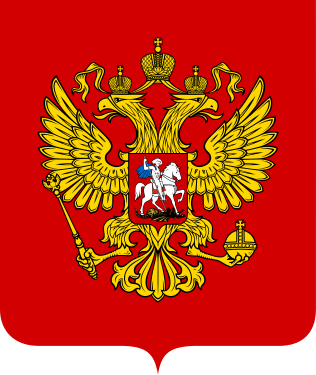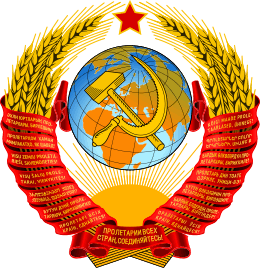North Caucasus
The North Caucasus (Russian: Северный Кавказ, tr. Severnyy Kavkaz, IPA: [ˈsʲevʲɪrnɨj kɐfˈkas]), or Ciscaucasia (Russian: Предкавказье, tr. Predkavkazye), is the northern part of the Caucasus region between the Sea of Azov and Black Sea on the west and the Caspian Sea on the east, in Russia. Geographically, the Northern Caucasus (territory north of the Greater Caucasus Range) includes the Russian republics and krais of the North Caucasus. As part of the Russian Federation, the Northern Caucasus region is included in the North Caucasian and Southern Federal Districts and consists of Krasnodar Krai, Stavropol Krai, and the constituent republics, approximately from west to east: the Republic of Adygea, Karachay–Cherkessia, Kabardino-Balkaria, North Ossetia–Alania, Ingushetia, Chechnya, and the Republic of Dagestan.[1]
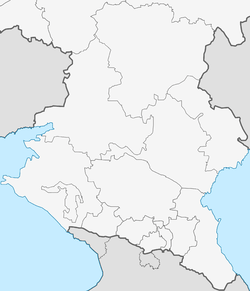
est-
an
rakh-
an
Oblast
- Red: NC economic region, former NC krai, former NC military okrug
- Green: former NC military okrug
- Blue: NC economic region, NC federal okrug, former NC military okrug
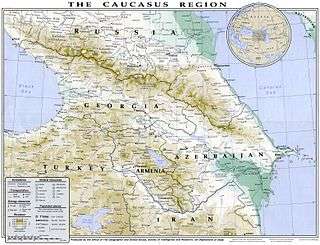
Geographically, the term North Caucasus also refers to the northern slope and western extremity of the Caucasus Major mountain range, as well as a part of its southern slope to the West. The northern part of the North Caucasus is typically considered part of Eastern Europe. The Forecaucasus steppe area is often also encompassed under the notion of "Ciscaucasus", thus the northern boundary of the Forecaucasus steppe is generally considered to be the Manych River.
History
Ciscaucasus was historically covered by the Pontic steppe, mostly on fertile calcareous chernozyom soils, which has been almost completely tilled and grazed. It is bounded by the Sea of Azov on the west, and the Caspian Sea on the east. According to the Concise Atlas of the World, Second Edition (2008), the Ciscaucasus region lies on the European side of the "commonly-accepted division" that separates Europe from Asia.
Much of the Northern Caucasus seceded from Russia in March of 1917 as the Chechen-dominated Mountainous Republic of the Northern Caucasus, taking advantage of the instability caused by the February Revolution and becoming a minor participant in the Russian Civil War. Mountainous Republic troops engaged in fierce clashes against the invading White General Anton Denikin's Volunteer Army, before the latter's defeat at the hands of the Red Army. The region was informally occupied by the Soviet Union shortly afterwards, and the republic was forced into accepting a nonviolent annexation in January of 1921. It was reformed into the Mountainous ASSR, which was later dissolved in October of 1924, replaced by a series of autonomous Okrugs and Oblasts.
The outer border of the Soviet Union's North Caucasus Krai was the same as that of present-day North Caucasus Economic Region (Raion) which includes an oblast (Rostov Oblast), two krais (Krasnodar Krai and Stavropol Krai), and seven republics. The former North Caucasus Military District (Okrug) also included Astrakhan Oblast, Volgograd Oblast, and the Republic of Kalmykia. Its administrative center was Rostov-on-Don until 10 January 1934, Pyatigorsk until January 1936, then Ordzhonikidze (today Vladikavkaz) and, from 15 December 1936, Voroshilovsk (today Stavropol).
In 2011, the Russian government has put forward plans to create a "North Caucasian version of Silicon Valley", at a cost of 32 billion rubles ($1.1 billion) as part of ongoing efforts to generate opportunities in the region.[2]
Gallery
 Location of the North Caucasian Federal District
Location of the North Caucasian Federal District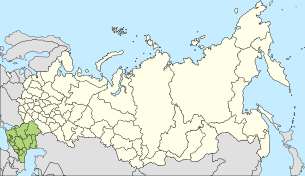 Map of former North Caucasus Military District (okrug)
Map of former North Caucasus Military District (okrug) Map of modern-day North Caucasus Economic Region (raion)
Map of modern-day North Caucasus Economic Region (raion) Flag of the Mountainous Republic
Flag of the Mountainous Republic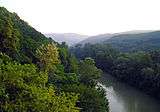 A wooded hill near Goryachy Klyuch, Krasnodar
A wooded hill near Goryachy Klyuch, Krasnodar
See also
- Caucasus
- Confederation of Mountain Peoples of the Caucasus
- Dolmens of North Caucasus
- Kuban People's Republic
- List of clashes in the North Caucasus
- Mountain Autonomous Soviet Socialist Republic
- Mountainous Republic of the Northern Caucasus
- North Caucasian Federal District
- North Caucasian Soviet Republic
- North Caucasus economic region
- North Caucasian Federal University
- North Caucasian Krai
- North Caucasian Military District
- North Caucasian Railway
- Southern Federal District
References
- A small schematic map of the regions can be seen at
- "Проект "Кремниевой долины" на Северном Кавказе обойдется в 32 млрд рублей" Proekt "Kreminevoj doliny" na Severnom Kavkaze obojdetsya v 32 mlrd rublej [The "Silicon Valley" project in the North Caucasus will cost 32 billion rubles]. Forbes.ru (in Russian). Moscow: Forbes. August 25, 2011. Retrieved March 27, 2017.
Further reading
- In Quest for God and Freedom: Sufi Responses to the Russian Advance in the North Caucasus by Anna Zelkina
- Russia in the Modern World: A New Geography by Denis J. B. Shaw, Institute of British Geographers
External links


- Relations between The North and South Caucasus. Articles in the Caucasus Analytical Digest No. 27
